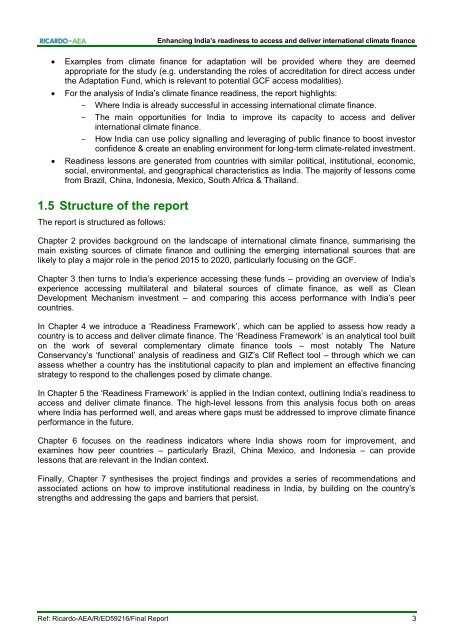Enhancing India’s Readiness to Climate Finance
India has taken several steps to improve its national response to climate change. India’s climate finance requirements, however, are very high, and will need to be met through a combination of public, private and international climate finance. See more at: http://shaktifoundation.in/
India has taken several steps to improve its national response to climate change. India’s climate finance requirements, however, are very high, and will need to be met through a combination of public, private and international climate finance. See more at: http://shaktifoundation.in/
- No tags were found...
You also want an ePaper? Increase the reach of your titles
YUMPU automatically turns print PDFs into web optimized ePapers that Google loves.
<strong>Enhancing</strong> <strong>India’s</strong> readiness <strong>to</strong> access and deliver international climate finance<br />
<br />
<br />
<br />
Examples from climate finance for adaptation will be provided where they are deemed<br />
appropriate for the study (e.g. understanding the roles of accreditation for direct access under<br />
the Adaptation Fund, which is relevant <strong>to</strong> potential GCF access modalities).<br />
For the analysis of <strong>India’s</strong> climate finance readiness, the report highlights:<br />
− Where India is already successful in accessing international climate finance.<br />
− The main opportunities for India <strong>to</strong> improve its capacity <strong>to</strong> access and deliver<br />
international climate finance.<br />
− How India can use policy signalling and leveraging of public finance <strong>to</strong> boost inves<strong>to</strong>r<br />
confidence & create an enabling environment for long-term climate-related investment.<br />
<strong>Readiness</strong> lessons are generated from countries with similar political, institutional, economic,<br />
social, environmental, and geographical characteristics as India. The majority of lessons come<br />
from Brazil, China, Indonesia, Mexico, South Africa & Thailand.<br />
1.5 Structure of the report<br />
The report is structured as follows:<br />
Chapter 2 provides background on the landscape of international climate finance, summarising the<br />
main existing sources of climate finance and outlining the emerging international sources that are<br />
likely <strong>to</strong> play a major role in the period 2015 <strong>to</strong> 2020, particularly focusing on the GCF.<br />
Chapter 3 then turns <strong>to</strong> <strong>India’s</strong> experience accessing these funds – providing an overview of <strong>India’s</strong><br />
experience accessing multilateral and bilateral sources of climate finance, as well as Clean<br />
Development Mechanism investment – and comparing this access performance with <strong>India’s</strong> peer<br />
countries.<br />
In Chapter 4 we introduce a ‘<strong>Readiness</strong> Framework’, which can be applied <strong>to</strong> assess how ready a<br />
country is <strong>to</strong> access and deliver climate finance. The ‘<strong>Readiness</strong> Framework’ is an analytical <strong>to</strong>ol built<br />
on the work of several complementary climate finance <strong>to</strong>ols – most notably The Nature<br />
Conservancy’s ‘functional’ analysis of readiness and GIZ’s Clif Reflect <strong>to</strong>ol – through which we can<br />
assess whether a country has the institutional capacity <strong>to</strong> plan and implement an effective financing<br />
strategy <strong>to</strong> respond <strong>to</strong> the challenges posed by climate change.<br />
In Chapter 5 the ‘<strong>Readiness</strong> Framework’ is applied in the Indian context, outlining <strong>India’s</strong> readiness <strong>to</strong><br />
access and deliver climate finance. The high-level lessons from this analysis focus both on areas<br />
where India has performed well, and areas where gaps must be addressed <strong>to</strong> improve climate finance<br />
performance in the future.<br />
Chapter 6 focuses on the readiness indica<strong>to</strong>rs where India shows room for improvement, and<br />
examines how peer countries – particularly Brazil, China Mexico, and Indonesia – can provide<br />
lessons that are relevant in the Indian context.<br />
Finally, Chapter 7 synthesises the project findings and provides a series of recommendations and<br />
associated actions on how <strong>to</strong> improve institutional readiness in India, by building on the country’s<br />
strengths and addressing the gaps and barriers that persist.<br />
Ref: Ricardo-AEA/R/ED59216/Final Report<br />
3

















